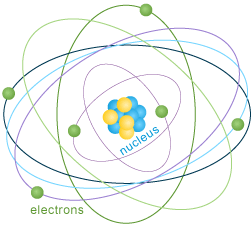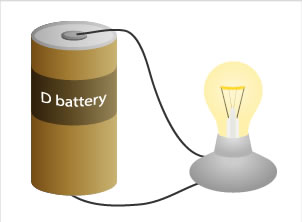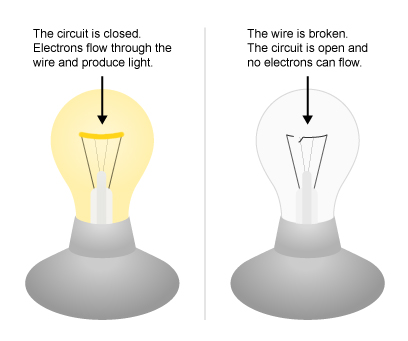Science of Electricity Basics
Everything is made of atoms
To understand electricity, some basic information about atoms is helpful. Atoms are the building blocks of the universe. Everything in the universe is made of atoms—every star, every tree, and every animal. The human body is made of atoms. Air and water are made of atoms, too. Atoms are so small that millions of them would fit on the head of a pin.
Atoms are made of even smaller particles
The center of an atom is called the nucleus. The nucleus is made up of particles called protons and neutrons. Electrons spin around the nucleus in shells. If the nucleus was the size of a tennis ball, the atom would be the size of a sphere about 1,450 feet in diameter, or about the size of one of the largest sports stadiums in the world. Atoms are mostly empty space.

If the naked eye could see an atom, it would look a little like a tiny cluster of balls surrounded by giant invisible bubbles (or shells). The electrons would be on the surface of the bubbles, constantly spinning and moving to stay as far away from each other as possible. Electrons are held in their shells by an electrical force.
The protons and electrons of an atom are attracted to each other. They both carry an electrical charge. Protons have a positive charge (+) and electrons have a negative charge (-). The positive charge of the protons is equal to the negative charge of the electrons. Opposite charges attract each other. An atom is in balance when it has an equal number of protons and electrons. The neutrons carry no charge and their number can vary.
The number of protons in an atom determines the kind of atom, or element, it is. An element is a substance consisting of one type of atom. The Periodic Table of Elements shows elements with their atomic numbers—the number of protons they have. For example, every atom of hydrogen (H) has one proton and every atom of carbon (C) has six protons.
Electricity is the movement of electrons between atoms

Electrons usually remain a constant distance from the atom's nucleus in precise shells. The shell closest to the nucleus can hold two electrons. The next shell can hold up to eight. The outer shells can hold even more. Some atoms with many protons can have as many as seven shells with electrons in them.
The electrons in the shells closest to the nucleus have a strong force of attraction to the protons. Sometimes, the electrons in an atom's outermost shells do not have a strong force of attraction to the protons. These electrons can be pushed out of their orbits. Applying a force can make them shift from one atom to another. These shifting electrons are electricity.
Static electricity exists in nature
Lightning is a form of electricity. Lightning is electrons moving from one cloud to another or electrons jumping from a cloud to the ground. Have you ever felt a shock when you touched an object after walking across a carpet? A stream of electrons jumped to you from that object. This is called static electricity.
Have you ever made your hair stand straight up by rubbing a balloon on it? If so, you rubbed some electrons off the balloon. The electrons moved into your hair from the balloon. The electrons tried to get far away from each other by moving to the ends of your hair. They pushed against or repelled each other and made your hair move. Just as opposite charges attract each other, like charges repel each other.
Magnets and Electricity



Source: National Energy Education Development Project (public domain)
The spinning of the electrons around the nucleus of an atom creates a tiny magnetic field. The electrons in most objects spin in random directions, and their magnetic forces cancel each other out.
Magnets are different because the molecules in magnets are arranged so that their electrons spin in the same direction. This arrangement and movement creates a magnetic force that flows out from a north-seeking pole and from a south-seeking pole. This magnetic force creates a magnetic field around a magnet.
Have you ever held two magnets close to each other? They don't act like most objects. If you try to push the two north poles or two south poles together, they repel each other. But if you put a north pole and a south pole together, the magnets will stick together because the north and south poles attract each other. Just like protons and electrons—opposites attract in magnets.
Magnetic fields can be used to make electricity
The properties of magnets are used to make electricity. Moving magnetic fields pull and push electrons. Metals such as copper and aluminum have electrons that are loosely held. Moving a magnet around a coil of wire, or moving a coil of wire around a magnet, pushes the electrons in the wire and creates an electrical current. Electricity generators essentially convert kinetic energy (the energy of motion) into electrical energy.
Batteries, Circuits, & Transformers
Batteries produce electricity

Source: Adapted from National Energy Education Development Project (public domain)
An electrochemical battery produces electricity with two different metals in a chemical substance called an electrolyte. One end of the battery is attached to one of the metals, and the other end is attached to the other metal. A chemical reaction between the metals and the electrolyte frees more electrons in one metal than it does in the other.
The metal that frees more electrons develops a positive charge, and the other metal develops a negative charge. If an electrical conductor, or wire, connects one end of the battery to the other, electrons flow through the wire to balance the electrical charge.
An electrical load is a device that uses electricity to do work or to perform a job. If an electrical load—such as an incandescent light bulb—is placed along the wire, the electricity can do work as it flows through the wire and the light bulb. Electrons flow from the negative end of the battery through the wire and the light bulb and back to the positive end of the battery.
Electricity travels in circuits
Electricity must have a complete path, or electrical circuit, before the electrons can move. The switch or on-off button on all electrical devices closes (turns on) or opens (turns off) an electrical circuit in the device. Turning—or switching—off a light opens a circuit and electrons cannot flow through the light. Turning on a light closes a circuit, which allows electricity to flow from one electric wire, through the light bulb, and then through another wire.
An incandescent light bulb produces light as electricity flows through a tiny wire in the bulb, which gets very hot and glows. An incandescent light bulb burns out when the tiny wire inside the bulb breaks, which opens the circuit.

Source: Adapted from National Energy Education Development Project (public domain)
Transformers help to move electricity efficiently over long distances
To solve the problem of sending electricity over long distances, William Stanley developed a device called a transformer. A transformer changes the voltage of electricity in a conductor or power line. High-voltage transmission lines, such as those that hang between tall metal towers, carry electricity over long distances to where it is needed. Higher voltage electricity is more efficient and less expensive for long distance electricity transmission. Lower voltage electricity is safer for use in homes and businesses. Transformers increase (step up) or reduce (step down) voltages as electricity moves from power plants to homes and businesses.
Measuring Electricity
Electricity is measured in Watts and kilowatts

Source: Stock photography (copyrighted)

Source: Stock photography (copyrighted)
Electricity is measured in units of power called Watts, named to honor James Watt, the inventor of the steam engine. A Watt is the unit of electrical power equal to one ampere under the pressure of one volt.
One Watt is a small amount of power. Some devices require only a few Watts to operate, and other devices require larger amounts. The power consumption of small devices is usually measured in Watts, and the power consumption of larger devices is measured in kilowatts (kW), or 1,000 Watts.
Electricity generation capacity is often measured in multiples of kilowatts, such as megawatts (MW) and gigawatts (GW). One MW is 1,000 kW (or 1,000,000 Watts), and one GW is 1,000 MW (or 1,000,000,000 Watts).
Electricity use over time is measured in Watthours
A Watthour (Wh) is equal to the energy of one Watt steadily supplied to, or taken from, an electric circuit for one hour. The amount of electricity that a power plant generates or an electric utility customer uses is typically measured in kilowatthours (kWh). One kWh is one kilowatt generated or consumed for one hour. For example, if you use a 40-Watt (0.04 kW) light bulb for five hours, you have used 200 Wh, or 0.2 kWh, of electrical energy.
Utility companies measure and monitor electricity use with meters
Electric utilities measure the electricity consumption of their customers with meters that are usually located on the outside of the customer's property where the power line enters the property. In the past, all electricity meters were mechanical devices that a utility employee had to read manually. Eventually, automated reader devices became available. These meters periodically report electricity use to utilities from mechanical meters with an electronic signal. Now, many utilities use electronic smart meters, which provide wireless access to the meter's power usage data, to measure electricity consumption in real-time. Some smart meters can even measure the electricity use of individual devices and allow the utility or customer to control electricity use remotely.
How Electricity is Generated
How electricity is generated

Source: Adapted from Energy for Keeps (public domain)
In 1831, scientist Michael Faraday discovered that when a magnet is moved inside a coil of wire, an electric current flows in the wire. An electricity generator is a device that converts a form of energy into electricity. Generators operate because of the relationship between magnetism and electricity. Generators that convert kinetic (mechanical) energy into electrical energy produce nearly all of the electricity that consumers use.
A common method of producing electricity is from generators with an electromagnet—a magnet produced by electricity—not a traditional magnet. The generator has a series of insulated coils of wire that form a stationary cylinder. This cylinder surrounds a rotary electromagnetic shaft. When the electromagnetic shaft rotates, it induces a small electric current in each section of the wire coil. Each section of the wire coil becomes a small, separate electric conductor. The small currents of the individual sections combine to form one large current. This current is the electricity that moves through power lines from generators to consumers.
Most of U.S. electricity generation is from electric power plants that use a turbine or similar machine to drive electricity generators.
A turbine converts the potential and kinetic energy of a moving fluid (liquid or gas) to mechanical energy. In a turbine generator, a moving fluid—such as water, steam, combustion gases, or air—pushes a series of blades mounted on a shaft, which rotates the shaft connected to a generator. The generator, in turn, converts the mechanical energy to electrical energy based on the relationship between magnetism and electricity.
Different types of turbines include steam turbines, combustion (gas) turbines, water (hydroelectric) turbines, and wind turbines. In steam turbines, hot water and steam are produced by burning a fuel in a boiler or by using a heat exchanger to capture heat from a fluid heated with, for example, solar or geothermal energy. The steam drives a turbine, which powers a generator. The fuels or energy sources used for steam turbines include biomass, coal, geothermal energy, petroleum fuels, natural gas, nuclear energy, and solar thermal energy. Most of the largest electric power plants in the United States have steam turbines.
Combustion gas turbines, which are similar to jet engines, burn gaseous or liquid fuels to produce hot gases to turn the blades in the turbine.
Internal combustion engines, such as diesel engines, are also used to produce mechanical energy to operate electricity generators. Diesel-engine generators are used in many remote villages in Alaska and are widely used for power supply at construction sites and for emergency or backup power supply for buildings and power plants. Diesel-engine generators can use a variety of fuels including petroleum diesel, biodiesel, natural gas, biogas, and propane. Small internal combustion engine generators fueled with gasoline, natural gas, or propane are commonly used by construction crews and tradespeople and for emergency power supply for homes.
Combined-heat-and-power (CHP) plants, sometimes called cogenerators, use the heat that is not directly converted to electricity in a steam turbine, combustion turbine, or an internal combustion engine generator for other purposes, such as space heating or industrial process heat. Some power plants use the unused heat or combustion gases from one turbine, such as a gas turbine, to generate more electricity in another turbine, such as a steam turbine. This system of two separate generators using a single fuel source is called a combined cycle. CHP and combined-cycle power plants are some of the most efficient ways to convert a fuel into useful energy.
Hydroelectric turbines use water to spin turbine blades, and wind turbines use the wind.
Electricity generators that do not use turbines include solar photovoltaic cells, which convert sunlight directly into electricity, and fuel cells, which convert fuels, such as hydrogen, into electricity through a chemical process.
The share of total U.S. utility-scale electricity generation in 2017 by major types of electricity generators
- Steam turbines–64%
- Combustion turbines–21%
- Hydroelectric turbines–7%
- Wind turbines–6%
- Solar photovoltaic systems–1%
- Internal combustion engines–less than 1%

